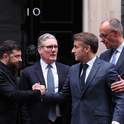History is not neutral. Public history is even less so. As Colston toppled and people around the country began challenging their own monuments, Boris Johnson took to social media last week to warn that “we cannot now try to edit or censor our past.” This week, writing in Telegraph, he has doubled down on that message, insisting that we cannot “re-write the past” nor “edit or photoshop the entire cultural landscape.” Yet, in castigating anti-racism protestors who are engaging with history in real time, it is the prime minister who is censoring history in the present. The removal of and debate about historical statues is making history in itself. After all, history as a discipline is not static, but rather a fluid appraisal of the past refracted through the present. Protests and protestors are not always right, but they are always a part of history in the making.
Statues and other parts of our built environment are not neutral artefacts of a fixed past. Their creation and display reflect the values of their time—crucially, they reflect the time of their creation rather than the time they portray. The Victorians were prolific public space makers and invaders. They bequeathed us many of the public spaces we celebrate today. Their choices about who to commemorate were no more neutral than our choices about which commemorations to maintain. Their agenda was an imperial one— their monuments stage-managed the values of race, class and gender that underpinned Victorian society. More often than not, statues were erected by a handful of white men on local city councils.
In the 19th century, the campaign to commission the Colston statue was met with a distinct lack of interest—even within Colston’s own Victorian fan club. The statue creation was the brainchild of one man, Mr J. W. Arrowsmith, a book printer and member of the Colston Fraternal Society. His initial attempts to fund the statue by appealing to the various Colston philanthropic societies of Bristol fell on largely deaf ears. As the Bristol Mercury of 1895 tells us, both the first and second appeal were so unsuccessful that the statue was created instead as part of a Handicrafts Exhibit, itself run by a committee of only seven men. The Colston statue reflected the niche interests of a handful of men and didn’t have large-scale support even at the time of its commission. The funds were ultimately scraped together from the first and second appeal (£201 + £407), the Handicrafts Exhibition (£200), and a final somewhat desperate appeal in the last month of 1895 (£50). To put that into context, each of the three main Colston philanthropic organisations of Bristol raised c.£3,500 annually by the early 1890s. Even Victorian Colston aficionados weren’t animated by his memorialisation.
Victorian statues were thus neither a national, nor a democratic expression of collective identity. The real historical lie here is to imagine that civic space represented anyone more than the city aldermen and business grandees who had the cash to shape their public sphere. The second “distortion of history” in the present is to continually insist that this debate is about the statue of Churchill, rather than the countless Victorian statues that continue to shape our towns and cities. Indeed, the biggest distortion here is in interpreting current events as merely a debate on statues, rather than a movement challenging deeper institutional and structural issues that the Black Lives Matter protestors are speaking to.
Because after all, the built environment shapes public space and manages who is welcomed and who is marginalised in the civic sphere. The statue of Edward Colston was not erected to celebrate the slave trade, but it did work to erase Britain’s participation in that trade. Its focus on Colston’s public stature as “one of the most virtuous and wise sons” of Bristol as a city (according to its inscription) censored the Royal African Company’s history of enslavement. Its continued occupation of public space made that space hostile for many of its citizens. It may not have actively celebrated slavery, but it said that the enslavement of African people was not a deal-breaker for the collective identity of the city.
If indeed, as Johnson suggests, statues of slave traders and colonisers “teach us about our past, with all its faults” they also teach us about our present, and who we as a nation are happy to marginalise for the sake of a white-knuckled adherence to selective memories of our collective past.
It's statues that edit the past—not their removal
Editing the past to tell some stories while silencing others is exactly what public commemorations do—even in the 19th century, the campaign to commission the Colston statue was met with a distinct lack of interest
June 17, 2020

Cecil Rhodes statue stands at the front facade of the Oriel College in Oxford during the protest. Cecil was an English-born businessman, mining magnate, and politician in South Africa. The founder of the diamond company De Beers and the founder of the sta











